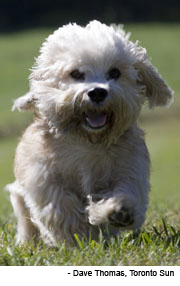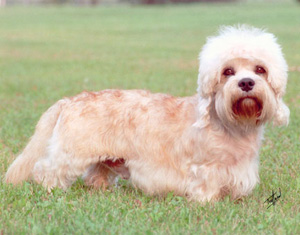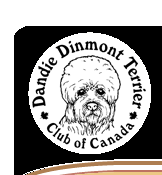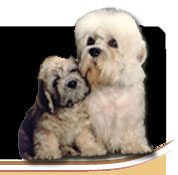 Hardy, healthy, long-lived, non-shedding, portable, calm, serene and utterly devoted
- these qualities make the rare and unique Dandie Dinmont - the first named Terrier - the ideal house pet.
Hardy, healthy, long-lived, non-shedding, portable, calm, serene and utterly devoted
- these qualities make the rare and unique Dandie Dinmont - the first named Terrier - the ideal house pet.
The Dandie Dinmont Terrier was bred from selected specimens of the rough native terrier in the Border country
between England and Scotland during the late 17th century. A direct line of these dogs descended to the farmers
in the Teviotdale Hills where Sir Walter Scott chanced upon them and - charmed - made them famous in his 1815 novel
"GUY MANNERING". His character, "Dandie Dinmont", a farmer, kept the immortal six - "Auld
Pepper", "Auld Mustard", "Young Pepper", "Young Mustard", "Little Pepper"
and "Little Mustard". (Mustard and Pepper are the two colours of the Dandie Dinmont Terrier.) The breed
soon became as popular as the novel, and was known thereafter as Dandie Dinmont Terriers.
Sir Walter described their pluck: "I have them a' regularly entered, first wi' rottens (rats), then
wi' stoats or weasels, and then wi' the tods (foxes) and brocks (badgers) and now they fear naething that ever
cam' wi' a hairy skin on 't." The shape of the Dandie is quite unlike the average terrier. From the
rounded dome of the head and the huge expressive eyes to the gentle curve of the body - there are no straight lines.
But his distinguishing point is his temperament. Mrs. William Kirby wrote: "Besides his quaint appearance, his
wisdom and his pluck, his courage and his watchfulness, what endears him most to all who know him is his responsiveness.
If you are tired of the indifference of certain breeds you will be charmed with the warmth of the Dandie's nature and
his constant awareness of you. Only his loyalty to you will exceed your loyalty to him."

Although courageous, (and his loud, surprisingly deep bark makes him a useful watchdog), he is patient and gentle
with a child. In 1938 Mrs. T. M. Simpson-Show wrote "…consider his character and his amazing brain, his wisdom
and his devotion to his owner. These points alone stamp him as something more than a 'mere dog'. In my long experience
of the breed, I have only known of one owner who gave up Dandies to take up another breed. Does not that help to prove
what the Dandie is and how he can win and keep lifelong attachments?"
The final word goes to the prominent veterinarian Frank Manolson, who in his book "D is for Dog" describes
the Dandie as one "who looks and acts like a grizzled backwoodsman shopping in Tiffany's. If you want a real
individualist, you simply must consider the Dandie Dinmont."
|
|


